Forum on trading, automated trading systems and testing trading strategies
Something Interesting to Read July 2014
newdigital, 2014.07.23 16:13
Technical Analysis of Stock Trends

2011 Reprint of 1958 Fourth Edition. Full facsimile of the original
edition, not reproduced with Optical Recognition Software. In 1948
Robert D. Edwards and John Magee published "Technical Analysis of Stock
Trends" which is widely considered to be one of the seminal works of the
discipline. It is exclusively concerned with trend analysis and chart
patterns and remains in use to the present. As is obvious, early
technical analysis was almost exclusively the analysis of charts,
because the processing power of computers was not available for
statistical analysis. "Technical analysis" is a financial term used to
denote a security analysis discipline for forecasting the direction of
prices through the study of past market data, primarily price and
volume. Behavioral economics and quantitative analysis incorporate
technical analysis, which being an aspect of active management stands in
contradiction to much of modern portfolio theory.
Forum on trading, automated trading systems and testing trading strategies
Something Interesting to Read July 2014
newdigital, 2014.07.21 09:49
GDP: A Brief but Affectionate History
by
Diane Coyle
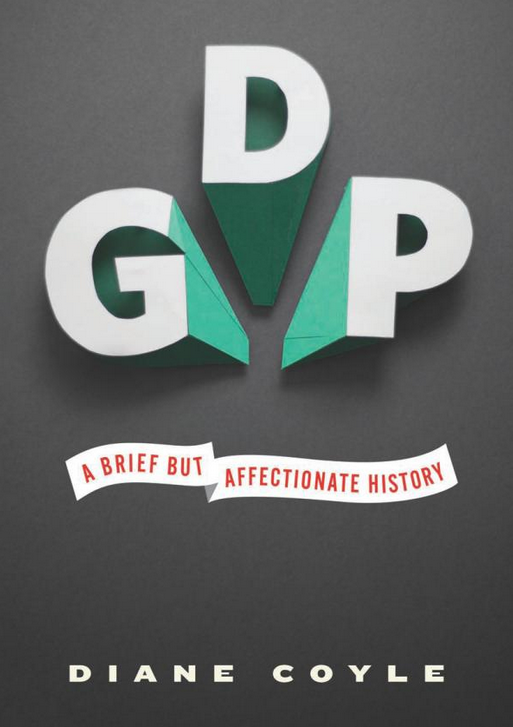
Why did the size of the U.S. economy increase by 3 percent on one day in mid-2013--or Ghana's balloon by 60 percent overnight in 2010? Why did the U.K. financial industry show its fastest expansion ever at the end of 2008--just as the world's financial system went into meltdown? And why was Greece's chief statistician charged with treason in 2013 for apparently doing nothing more than trying to accurately report the size of his country's economy? The answers to all these questions lie in the way we define and measure national economies around the world: Gross Domestic Product. This entertaining and informative book tells the story of GDP, making sense of a statistic that appears constantly in the news, business, and politics, and that seems to rule our lives--but that hardly anyone actually understands.
Diane Coyle traces the history of this artificial, abstract, complex, but exceedingly important statistic from its eighteenth- and nineteenth-century precursors through its invention in the 1940s and its postwar golden age, and then through the Great Crash up to today. The reader learns why this standard measure of the size of a country's economy was invented, how it has changed over the decades, and what its strengths and weaknesses are. The book explains why even small changes in GDP can decide elections, influence major political decisions, and determine whether countries can keep borrowing or be thrown into recession. The book ends by making the case that GDP was a good measure for the twentieth century but is increasingly inappropriate for a twenty-first-century economy driven by innovation, services, and intangible goods.
by Jeremy du Plessis
Point and Figure charts are one of the great secrets of the Technical
Analysis world. Highly sophisticated and with a thoroughbred pedigree,
they can, however, be overlooked by traders today.
Jeremy du Plessis -
one of the foremost Point and Figure experts in the world - returns with
a fully updated second edition of this definitive guide in an effort to
redress this imbalance. This second edition, with an extensive revision
to the text and introduction of brand new techniques, demystifies the
world of Point and Figure charting. It includes a detailed explanation
of the history and development of the technique from its invention to
the modern day, and covers the makeup of the chart patterns, why they
are created, and how to interpret them.
Throughout, readers are
encouraged to understand Point and Figure charts from first principles,
rather than just remember the names of a series of patterns. It is the
first major work for 50 years to discuss in depth the original 1-box
reversal method of Point and Figure charting and contrast it with the
more popular 3-box reversal method.
Further, the explanation of how to
use Point and Figure charts to project targets and calculate risk-reward
ratios is the most comprehensive ever seen. Also featured in the second
edition are:
- A step-by-step analysis of the FTSE 100 Index using the
3-box method, as well as the NASDAQ Composite Index, using the 1-box
method
- A detailed discussion of optimising techniques
- An in-depth
chapter on Analysing Point and Figure charts, extensively rewritten from
the first edition
- A new explanation of how Point and Figure
parameters are chosen and the implications of choosing them
- Two new
Point and Figure construction methods never seen before
- Point and
Figure's contribution to market breadth, with a look at bullish percent
and two brand new indicators
- Full discussion of Point and Figure gaps
and how they provide valuable information about the chart
- Lesser
known, more advanced techniques such as the use of moving averages,
parabolic SAR and Bollinger Bands on Point and Figure charts
- Price and
volume activity histograms and how they provide information about
support and resistance
All this is illustrated with numerous colour charts and observations from years of trading experience. According to du Plessis, Point and Figure charts are the 'voice of the market'. This book helps you listen to, and understand, that voice. Part of the Market Technicians Association (MTA) Required Reading list.
A Three Dimensional Approach To Forex Trading : Anna Coulling
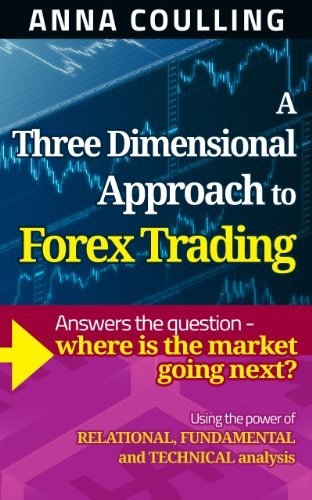
If you aspire to becoming a full time forex trader, then this is the book for you. Even if your dream is perhaps more modest, and you simply want to have a second income trading the forex markets, then again, this book is for you. It has been written with one clear objective in mind. To explain how and why currencies move in the way that they do, using the combined power of relational, technical and fundamental analysis. Combine this with a three dimensional approach to trading itself, using multiple time frames and multiple chart analysis, and the world of foreign exchange will become crystal clear. Many aspiring traders, simply do not realize that the forex market sits at the heart of the financial world, which, when you think about it logically, is really common sense. After all, this is the biggest money market in the world, and if the financial markets are about one thing, they are about money. Making it, protecting it, or increasing the return. It’s no surprise therefore, that the forex market connects all the others. It is the central axis of the financial world, around which all the others spin. In the book, you will discover how changes in market sentiment in the primary markets of commodities, stocks, bonds and equities, are then reflected in the currency markets. This is something which often surprises novice traders. After all, why look at a stock index, or the price of gold, or a bond market? The answer is very simple. It is in these markets where you will find all the clues and signals, which then reveal money flow. After all, the financial markets are all about risk. In other words, higher returns for higher risk, or lower returns for lower risk. It really is that simple. And yet, how many forex traders ever consider associated markets. The answer is very few. You will be one of those enlightened traders who truly understands money flow and risk, and your confidence as a trader will grow exponentially as a result. And in case you were wondering, this is NOT another book explaining forex trading strategies. In fact there are none at all, surprising given the book's length. If this is what you are looking for, please DO NOT buy this book. It has been written for two specific audiences. The first is the novice forex trader, for whom this is a new market. The second is the forex trader who has attempted to trade in foreign exchange, but failed, and has been left confused by the apparent random and chaotic behavior of this volatile market. Reading this book will provide you with a deep understanding of how and why the markets move in the way they do. Whilst the forex market is a complex mix, it is not complicated, once you understand the people, their motives and the currencies themselves. Each chapter builds on the last in a logical sequence, and every topic is explained in a simple and clear way. Even those markets such as bonds, which few traders ever understand, are explained very simply. Every topic is illustrated with clearly annotated charts, to help and guide you as you learn. Equally important is the concept of change. Indeed you may have other books on your bookshelf written many years ago and explaining how the forex market works. Well, as you will discover, the rule book has been torn up. No longer is this a simple market of trending currency pairs. This all changed in the financial tsunami which engulfed the world in 2007/2008, and with it the forex world changed too! If this is news to you, then yet another reason to buy the book. Long gone are the days when currency pairs meandered their way higher and lower in long term trends, driven by interest rate differentials. To take advantage, you need to understand the forces which now drive the markets. A Three Dimensional Approach To Forex Trading will empower you with knowledge. Knowledge and confidence go hand in hand. Confidence breeds success, and success breeds money, which will then flow from reading the book - Anna
New Trading Dimensions: How to Profit from Chaos in Stocks, Bonds, and Commodities : Bill Williams
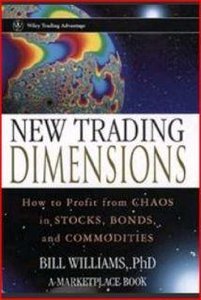
As today's market environment continues to change dramatically, more and
more traders are discovering that traditional forecasting methods-pure
technical analysis and fundamental analysis-just do not work. Sending
out contradictory messages, these opposing schools of thought leave
investors baffled about the future direction of the market, and
consequently, at a loss as to how to tailor their trading systems. As a
result, many practitioners have now turned to a new forecasting
"cocktail" that combines traditional charting methodologies with chaos
theory and human psychology. In this groundbreaking book, Bill Williams,
a seasoned trader at the forefront of this dynamic new approach,
explains exactly what it is, how it works in current stock and commodity
markets, and how to use it to your advantage.
Based on human
nature rather than the vagaries of the market, the new trading dimension
works on the premise that we trade not the market, but our own belief
system. By assessing what your personal biases are, you can determine
how they influence your ultimate success-or failure-and then adjust your
trading strategies accordingly.
Written by an expert in the
field who has been featured in Futures, Worth, Success, and other
prominent publications, New Trading Dimensions takes the latest in
scientific knowledge about human behavior and applies it directly to the
fields of stock and commodity investing and trading. With
straightforward guidelines, it shows you how to adopt the right attitude
toward the behavior of the market and use the right tools (ATTITOOLS)
for profitable trading. Packed with practice exercises, specific
applications to different types of investments, and a detailed review of
important market signals, here's where you'll learn how to:
* Discover what the market wants and align your own beliefs with the direction of the market
* Apply chaos theory to trading and investing
* Use Williams' "Market Alligator" for analyzing and profiting from the markets
*
Employ a multidimensional trading program that includes such tools and
techniques as fractals, oscillators, AC signals, psychological zones,
and balance lines
* Exit trades in a timely fashion to reap high returns
Drawing
on the author's more than forty years of experience as both a
successful trader and seasoned trainer, this invaluable guide offers a
breakthrough method that has proven its ability to turn investors into
consistent winners.
Forum on trading, automated trading systems and testing trading strategies
Something Interesting to Read April 2014
newdigital, 2014.04.14 20:48
Theory Of Stochastic Processes : With Applications to Financial Mathematics and Risk Theory
This book is a collection of exercises covering all the main topics in
the modern theory of stochastic processes and its applications,
including finance, actuarial mathematics, queuing theory, and risk
theory.
The aim of this book is to provide the reader with the theoretical and
practical material necessary for deeper understanding of the main topics
in the theory of stochastic processes and its related fields.
The book is divided into chapters according to the various topics. Each
chapter contains problems, hints, solutions, as well as a self-contained
theoretical part which gives all the necessary material for solving the
problems. References to the literature are also given.
The exercises have various levels of complexity and vary from simple
ones, useful for students studying basic notions and technique, to very
advanced ones that reveal some important theoretical facts and
constructions.
This book is one of the largest collections of problems in the theory of
stochastic processes and its applications. The problems in this book
can be useful for undergraduate and graduate students, as well as for
specialists in the theory of stochastic processes.
High Probability Trading : Take The Steps To Become A Successful Trader
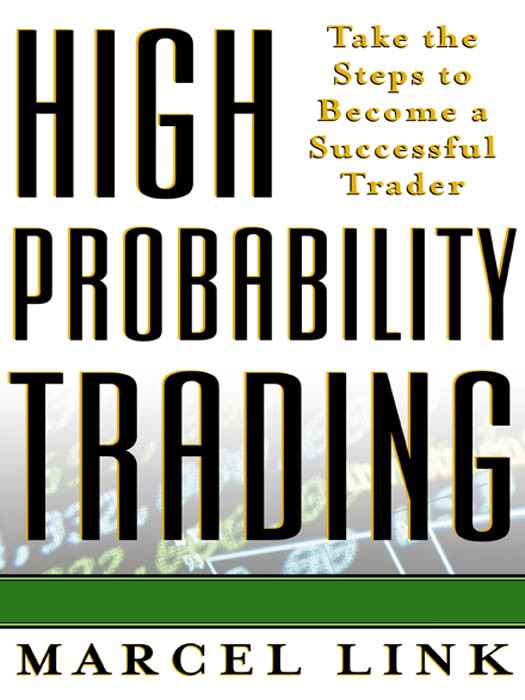
Before he became a successful trader, Marcel Link spent years wading from one system to the next, using trial and error to figure out what worked, what didn't, and why. In High Probability Trading, Link reveals the steps he took to become a consistent, patient, and winning trader--by learning what to watch for, what to watch out for, and what to do to make each trade a high probability trade.
"Why do a select few traders repeatedly make money while the masses lose? What do bad traders do that good traders avoid, and what do winning traders do that is different? Throughout this book I will detail how successful traders behave differently and consistently make money by making high probability trades and avoiding common pitfalls..."--From the preface
Within 6 months of beginning their careers full of promise and hope, most traders are literally out of money and out of trading. High Probability Trading reduces the likelihood that you will have to pay this "traders' tuition," by detailing a market-proven program for weathering those first few months and becoming a profitable trader from the beginning.
Combining a uniquely blunt look at the realities of trading with examples, charts, and case studies detailing actual hits and misses of both short- and long-term traders, this straightforward guidebook discusses:
- The 10 consistent attributes of a successful trader, and how to make them work for you
- Strategies for controlling emotions in the heat of trading battle
- Technical analysis methods for identifying trends, breakouts, reversals, and more
- Market-tested signals for consistently improving the timing of entry and exit points
- How to "trade the news"--and understand when the market has already discounted it
- Learning how to get out of a bad trade before it can hurt you
The best traders enter the markets only when the odds are in their favor. High Probability Trading shows you how to know the difference between low and high probability situations, and only trade the latter. It goes far beyond simply pointing out the weaknesses and blind spots that hinder most traders to explaining how those defects can be understood, overcome, and turned to each trader's advantage.
While it is a cliché, it is also true that there are no bad traders, only bad trades. Let High Probability Trading show you how to weed the bad trades from your trading day by helping you see them before they occur. Packed with charts, trading tips, and questions traders should be asking themselves, plus real examples of traders in every market situation, this powerful book will first give you the knowledge and tools you need to tame the markets and then show you how to meld them seamlessly into a customized trading program--one that will help you join the ranks of elite traders and increase your probability of success on every trade.
Bubble Value at Risk: Extremistan and Procyclicality : Max C.Y.Yong

This is a story of the illusion of risk measurement. Financial risk
management is in a state of confusion. The 2008 credit crisis has
wreaked havoc on the Basel pillars of supervision by highlighting all
the cracks in the current regulatory framework that had allowed the
credit crisis to fester, and ultimately leading to the greatest crisis
since the Great Depression. Policy responses were swift--UK's Financial
Services Authority (FSA) published the Turner Review which calls for a
revamp of many aspects of banking regulation, the Bank of International
Settlements (BIS) speedily passed a Revision to its Basel II, while the
Obama administration calls for a reregulation of the financial industry
reversing the Greenspan legacy of deregulation. The value-at-risk risk
measure, VaR, a central ideology for risk management, was found to be
wholly inadequate during the crisis. Critically, this "riskometer" is
used as the basis for regulatory capital--the safety buffer money set
aside by banks to protect against financial calamities. The foundation
of risk measurement is now questionable.
The first half of this
book develops the VaR riskometer with emphasis on its
traditionally-known weaknesses, and talks about current advances in risk
research. The underlying theme throughout the book is that VaR is a
faulty device during turbulent times and by its mathematical
sophistication misled risk controllers into an illusion of safety. The
author traces the fundamental flaw of VaR to its statistical
assumptions--of normality, i.i.d. and stationarity--the "gang of three".
These primitive assumptions are very pervasive in the frequentist
statistics philosophy where probability is viewed as an objective notion
and can be measured by sampling. A different school of thought, the
Bayesians, argues for subjective probability and has developed an entire
mathematical framework to incorporate the observer's opinion into the
measurement (but this is a subject matter for another publication). We
argue that the frequentist's strict mathematical sense often acts as a
blinder that restricts the way we view and model the real world. In
particular, two "newly" uncovered market phenomena-- extremistan and
procyclicality--cannot be engaged using the frequentist mindset. There
were already a few other well-known "market anomalies" that tripped the
VaR riskometer during the 2008 crisis. All these will be detailed later.
In Part IV of the book, the author proposes a new risk metric called bubble VaR (buVaR)
which does not invoke any of the said assumptions. BuVaR is not really a
precise measurement of risk; in fact it presumes that extreme loss
events are unknowable (extremistan) and moves on to the more pressing
problem--how do we build an effective buffer for regulatory capital that
is countercyclical, and that safeguards against extreme events. This
book is an appeal (as is this preface) to the reader to consider a new
paradigm of viewing risk--that one need not measure risk (with
precision) to protect against it. By being obsessively focused on
measuring risk, the risk controller may be fooled by the many pitfalls
of statistics and randomness. This could lead to a false sense of
security and control over events which are highly unpredictable. It is
ultimately a call for good judgment and pragmatism. This book is
intended to reach out to the top management of banks (CEOs and CROs), to
regulators, to policy makers and to risk practitioners--not all of whom
may be as quantitatively inclined as the specialized risk professional.
But they are the very influencers of the coming financial reregulation
drama. We are living in epic times and ideas help shape the world for
the better (or for worst). It is hoped that the ideas in this book can
open up new and constructive research into countercyclical measures of
risk.
The Practical Guide To Wall Street : Equities & Derivatives
- Clear, detailed and intuitive explanations of all major products, their function, pricing and risks (several of which are unavailable anywhere else despite producing billions of dollars in annual revenue for Wall St.)
- The layout of the trading floor, the roles and responsibilities of the different sales and trading groups and how they interact to service the client business
- An overview of the structure of the macro-economy and the trader’s perspective on the significance of economic data releases and their impact on the financial markets
- A review of those concepts from fundamental valuation and financial statement analysis of greatest relevance on the trading floor (as opposed to abstract valuation models)
- Practical details of the structure and functioning of the equity and derivative markets including translations of trader jargon, Bloomberg tips, market conventions, liquidity and risk considerations and much more…
This book provides the first comprehensive explanation of all aspects of the functioning of the equities division, with information, details and insights previously only available to those who already worked on a trading floor. The availability of this material in a format accessible to non-professionals fundamentally changes the level of industry knowledge employers in the financial services industry can expect of new hires.
Money And Power : How Goldman Sachs Came To Rule The World
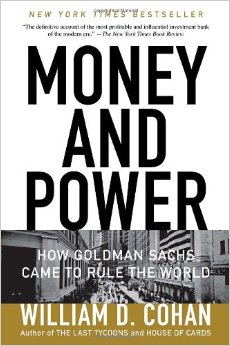
From the bestselling, prize-winning author of THE LAST TYCOONS and HOUSE
OF CARDS, a revelatory history of Goldman Sachs, the most dominant,
feared, and controversial investment bank in the world
For much of its storied 142-year history, Goldman Sachs has projected an
image of being better than its competitors--smarter, more collegial,
more ethical, and far more profitable. The firm--buttressed by the most
aggressive and sophisticated p.r. machine in the financial
industry--often boasts of "The Goldman Way," a business model predicated
on hiring the most talented people, indoctrinating them in a corporate
culture where partners stifle their egos for the greater good, and
honoring the "14 Principles," the first of which is "Our clients'
interests always come first."
But there is another way of viewing Goldman--a secretive money-making
machine that has straddled the line between conflict-of-interest and
legitimate deal-making for decades; a firm that has exerted undue
influence over government since the early part of the 20th century; a
company composed of "cyborgs" who are kept in line by an internal
"reputational risk department" staffed by former CIA operatives and
private investigators; a workplace rife with brutal power struggles; a
Wall Street titan whose clever bet against the mortgage market in
2007--a bet not revealed to its clients--may have made the financial
ruin of the Great Recession worse.
As William D. Cohan shows in his riveting chronicle of Goldman's rise to
the summit of world capitalism, the firm has shown a remarkable
ability to weather financial crises, congressional, federal and SEC
investigations, and numerous lawsuits, all with its reputation and its
enormous profits intact. By reading thousands of pages of government
documents, court cases, SEC filings, Freedom of Information Act papers
and other sources, and conducting over 100 interviews, including
interviews with clients, competitors, regulators, current and former
Goldman employees (including the six living men who have run Goldman),
Cohan has constructed a vivid narrative that looks behind the veil of
secrecy to reveal how Goldman has become so profitable, and so powerful.
Part of the answer is the firm's assiduous cultivation of people in
power--dating back to 1913, when Henry Goldman advised the government on
how the new Federal Reserve, designed to oversee Wall Street, should
be constituted. Sidney Weinberg, who ran the firm for four decades,
advised presidents from Roosevelt to Kennedy and was nicknamed "The
Politician" for his behind-the-scenes friendships with government
officials. Goldman executives ran fundraising efforts for Nixon, Reagan,
Clinton and George W. Bush. The firm showered lucrative consulting or
speaking fees on figures like Henry Kissinger and Lawrence Summers.
Famously, and fatefully, two Goldman leaders-- Robert Rubin and Henry
Paulson--became Secretaries of the Treasury, where their actions both
before and during the financial crisis of 2008 became the stuff of
controversy and conspiracy theories.
Another major strand in the firm's DNA is its eagerness to deal on both
sides of a transaction, eliding questions of conflict of interest by
the mere assertion of their innate honesty and nobility, a refrain
repeated many times in its history, most notoriously by current Goldman
CEO Lloyd Blankfein's jesting assertion that he was doing "God's
work."
As Michiko Kakutani's New York Times review of HOUSE OF CARDS said,
"Cohan writes with an insider's knowledge of the workings of Wall
Street, a reporter's investigative instincts and a natural storyteller's
narrative command." In MONEY & POWER, Cohan has marshaled all
these gifts in a powerful and definitive account of an institution
whose public claims of virtue look very much like ruthlessness when
exposed to the light of day.
- Free trading apps
- Over 8,000 signals for copying
- Economic news for exploring financial markets
You agree to website policy and terms of use
This is the thread about books related for stocks, forex, financial market and economics. Please make a post about books with possible cover image, short description and official link to buy (amazon for example).
Posts without books' presentation, without official link to buy and with refferal links will be deleted.Posts with links to unofficial resellers will be deleted